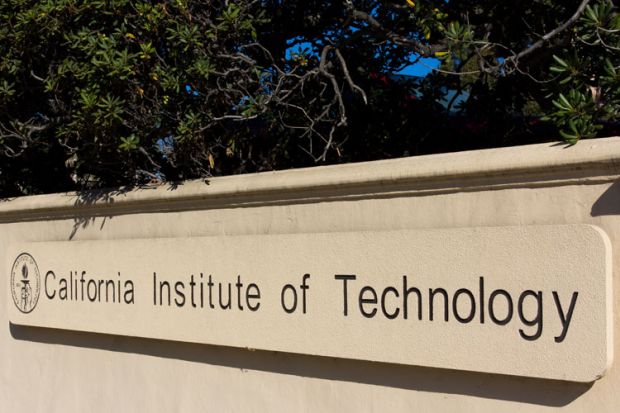Caltech: Student-Led Lunar Architecture Team Named Finalist in NASA Competition for Second Consecutive Year
Caused by collisions from asteroids, comets, and other astronomical objects, lunar craters give our moon its characteristic pockmarked façade. But the permanent shade and materials deposited by these celestial impacts offer more than just galactic style. These craters hold the materials necessary for building sustained human settlements on the moon.
Accessing the materials inside lunar craters is no easy task, as the craters feature steep slopes, built-up electrostatic charge, and a fluffy snow-like texture—all of which interfere with sensors and wheels. To overcome this challenge, NASA seeks new ways of getting around the moon that do not rely on wheels. The agency’s Breakthrough, Innovative, and Game-changing (BIG) Idea Challenge asks university teams to go beyond wheeled rovers and create new solutions to the problem of traversing lunar craters.
A team of more than 30 Caltech undergraduates in the Division of Engineering and Applied Science is among seven 2022 BIG Idea finalists. The team’s concept, known as LATTICE (Lunar Architecture for Tree Traversal in-service-of Cable Exploration), is a self-deploying, modular robotic system able to transport materials and hardware in and out of lunar craters. It builds on the experience gained from Caltech’s 2021 BIG Idea finalist project, HOMES, which tackled the problem of lunar dust.
LATTICE involves an infrastructure of cables and stakes which can transport materials across the moon, “similar to what is used in the logging industry,” says second-year Caltech undergraduate student Lucas Pabarcius. “We are trying to set up a permanent system of cables that any sort of tools or robot can leverage,” adds fourth-year Caltech undergraduate student Luis Pabon. “Putting a ski lift on the moon, essentially.”
However, the implications of the LATTICE concept extend far beyond the lunar surface. Indeed, the team’s work on this project can also help to lay the groundwork for travel and transport on the rough terrain of Mars and other objects in our solar system.
LATTICE comprises three separate interconnected systems: the stakes and anchoring systems to be driven into the moon’s regolith (its surface of broken-down rocks); a system for driving the stakes into the regolith; and the shuttles that will traverse the stakes via cables and transport cargo.
“The regolith on the moon is not well understood, so we are trying to develop our prototype to see how much force the stakes can hold and how to make changes in the anchoring system to hold up on the moon,” explains third-year Caltech undergraduate student Calle Junker.
The team’s ultimate goal is to perform a tech demo in the desert with a small-scale prototype. “We’ll go up to a sand dune, implant two stakes with our stake-driving module, and then place the cable between them to show how the shuttle can travel along that cable system, pick up a payload, and go back up the crater walls,” says Junker, who is focused on developing the stakes.
The tech demo is planned for mid-November; a detailed design review with mentors from JPL, which Caltech manages for NASA, is set for late May. The final design and fabrication of the LATTICE system will happen throughout the summer, when 10-12 Summer Undergraduate Research Fellowship (SURF) students will join the team. As summer 2022 ends, the team will be testing and validating LATTICE to prove that what they have designed and built actually works.
“Designing innovative systems for harvesting materials from lunar craters is a great example of the ability of Caltech’s especially talented students to gather ideas from multiple disciplines to address and solve real-world—and out-of-this-world—problems,” says Harry A. Atwater, Otis Booth Leadership Chair of the Division of Engineering and Applied Science, Howard Hughes Professor of Applied Physics and Materials Science, and director of the Liquid Sunlight Alliance.
“All of us are extremely excited for the tech demo at the end,” says third-year Caltech undergrad Kaila Coimbra. “We all have big dreams for the lead bot to go down a hill and lay down a stake, then we will have a shuttle go down. If we get all this to work by the end of November, we will be very happy with the results.”
The LATTICE team, which is funded by $180,000 from NASA and mentored by Soon-Jo Chung, Bren Professor of Aerospace and Control and Dynamical Systems and JPL research scientist, benefits from lessons learned in last year’s NASA Big Idea Challenge, which involved many of the same Caltech undergraduates. “Dust was the core of the challenge last year, so this year we get to apply that knowledge in how to make our system dust tolerant,” says Junker. Another lesson learned from the 2021 BIG Idea Challenge is the importance of teamwork in the development process. “I think we were putting too much on one person last year,” says Junker. “This year we are splitting up our work better.”
“It’s been amazing to be a part of a community of people who are trying to make something cool and novel,” says fourth-year Caltech undergraduate student Polina Verkhovodova. “The fact that the engineers at JPL are giving us advice and treating students as engineers on the same level is invaluable.”

